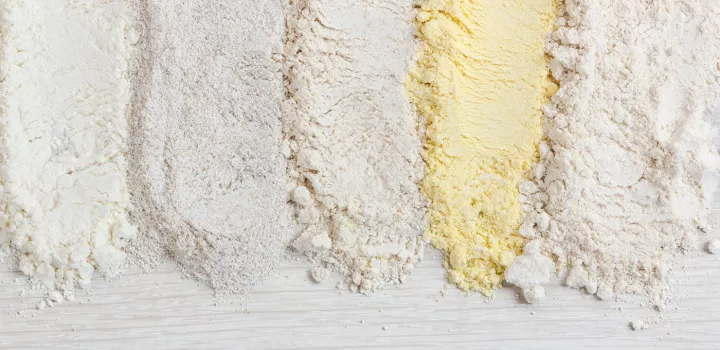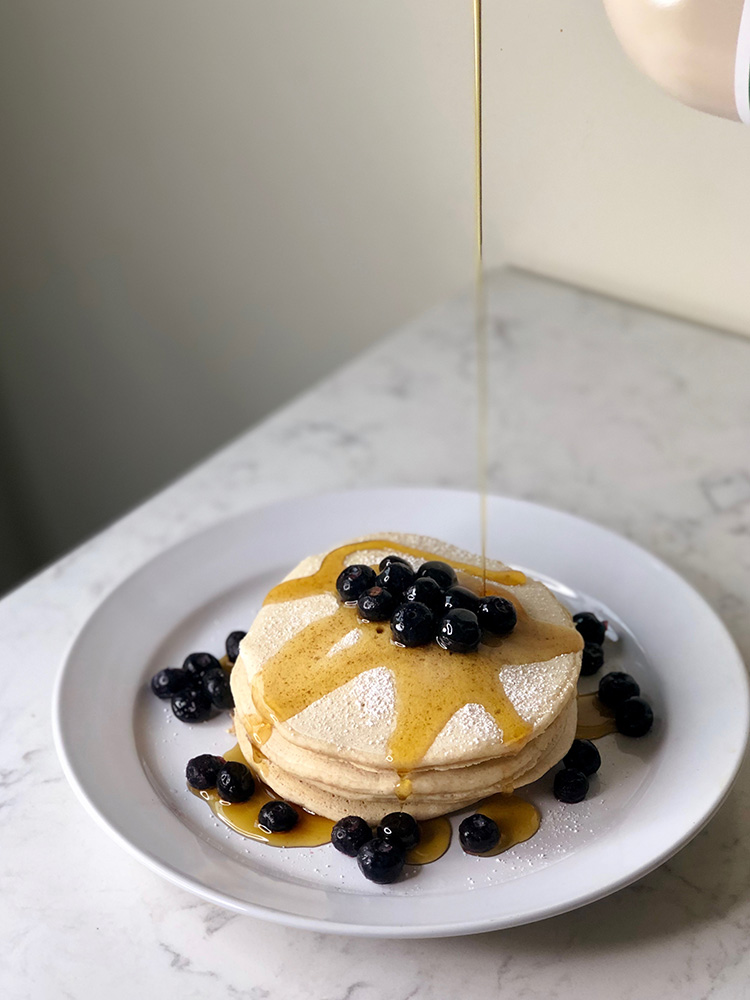
Four All-Purpose Flour Alternatives
Chef Palak Patel explores four wheat-free flours for baking and cooking.
A trip down the grocery store aisle today is dizzying with alternative flours popping up left and right. As allergies to wheat become more prevalent, many people find themselves looking for healthy wheat-flour alternatives. It can be daunting to pick which flour makes the most sense when it comes to baking and cooking.
We have a variety of options that will meet just about any need depending on personal preference, dietary restrictions and general demand for nutritious flours.
I haven’t experimented with every variety, however, I am pretty well-versed and biased towards a handful of flours. A little imagination, knowledge of ratios and confidence are what’s needed to brave the new mélange of options. Here’s a rundown of my all-time favorite flours, how they're made and my favorite dishes that use them.
Pro tip: Storing flour and nuts in a freezer extends the shelf life way beyond the dusty cupboard.
Explore more alternative ingredients in ICE’s Health-Supportive Culinary Arts program.
Chickpea Flour
Relatively new to American households, chickpea flour (also called garbanzo bean flour or besan in Indian kitchens) is arguably one of my favorite ingredients. When I was growing up in an Indian household, my mom bought chickpea flour in bulk and stored it in a bottomless plastic bucket — I’m talking 25-pound bags. It’s one of the most versatile flours, and my mom uses it in so many dishes like curries, bread and even desserts. Her signature dish is kadhi, a traditional Gujurati dish she makes two or three times a week that starts with a base of chickpea flour mixed with yogurt and water. It’s a great source of protein, an abundant dose of fiber and gluten-free.
Unlike many gluten-free flours, chickpea flour has endless binding power. A little water and oil with salt turn this pale yellow flour into a dense paste that’s capable of binding to anything. A little secret: Many Indian tandoori chicken recipes call for a small amount of chickpea flour paste to help keep the spices coated to the skin.
Rice Flour
Rice flour is pretty bland on its own but a really versatile option when it comes to making Asian dishes. The most common use for rice flour is to make a slurry to thicken sauces by stirring a little into a liquid. Similar to cornstarch, you can use white rice flour, brown rice flour or sweet glutinous rice flour, which, despite its name, is gluten-free. Brown and white rice flours are interchangeable in recipes but add different flavors. Use about 2 tablespoons per cup of liquid that needs to be thickened.
While I don’t fry much, there are a couple of recipes that I make in which rice flour plays an invaluable role. As a chef, rice flour is one of my secret ingredients to make anything fried light and airy in texture. In Asia, it’s used in everything from Japanese tempura vegetables to the ever-popular Korean fried chicken, giving fried foods their characteristic pillowy crunch. A key ingredient in the famous Thai dish chicken larb, a chopped meat salad with various Thai seasonings, is rice flour, which is toasted and mixed with the meat to help bind the sauce.
Almond Flour
All nut flours are made from grinding what’s leftover of nuts after the oil is removed, while nut meals are made from grinding the whole nut. I’ve found in recipes, most nut flours are interchangeable. After living in Italy, I became obsessed with an almond orange cake served at pretty much any reputable coffee shop. A pretty straightforward recipe to execute — a combination of eggs, sugar, oranges, vanilla extract and almond flour — it is a deliciously bold and immensely moist cake. The nut flour and sugar make this less than ideal for a light dessert, but given that it doesn’t have all-purpose flour or any oil, it’s healthier than a traditional cake. This recipe gets bonus points because I once made it directly on the stovetop and finished in the oven!
All nut flours add a great, rich flavor to baked goods. Nut flour can be higher in calories but is considered a healthy fat with more protein than regular and alternative flours, which can keep you feeling satisfied. I like using a mix of nut flour and buckwheat as a breading option for chicken cutlets. It’s very easy to make nut flour at home using a high-speed blender.
Explore four more alternative flours.
Buckwheat Flour
The newest to me is buckwheat flour. Don’t let the name fool you, it doesn’t contain wheat, it’s made from a seed. This is the “it flour” and my go-to for pancakes, muffins or savory crêpes. Buckwheat flour is packed with fiber and protein and has an assertive flavor and nutty aftertaste. At first glance, the flour is darker in color than other flours, but it has a wonderfully distinctive, lightly floral flavor and is used in just as many savory dishes as sweet. For anyone with a gluten intolerance or aim to cut back on regular flour, buckwheat flour can be used on its own in recipes or combined with other types of gluten-free flour like brown rice or even an all-purpose flour. If you’re feeling adventurous, try your hand at making soba noodles, blinis or these piece-of-cake pancakes at home with buckwheat flour.
Explore butter alternatives and alternative sweeteners.
Recipe

Buckwheat Flour Flapjacks
Ingredients
- 1/2 cup buckwheat flour
- 1/2 cup all-purpose or spelt flour
- 2 tablespoons sugar
- 1 tablespoon baking powder
- 1 tablespoon apple cider vinegar
- 1 teaspoon vanilla
- 1 cup almond milk
- Berries and syrup, optional but necessary
Directions
- Mix the dry ingredients.
- Mix the wet ingredients separately.
- Mix these together and let sit for 10 minutes. Ladle pancakes 1/2 cup at a time onto a non-stick pan.


Alternative flours
Submitted by Lynn on February 6, 2020 10:28am
Have you worked with Cassava Flour? Assuming you have, what is your insight?
Thanks
Cassava flour
Submitted by aday on June 25, 2021 11:59am
Hi Lynn, we covered cassava flour here:
https://www.ice.edu/blog/alternative-flour
Recipe
Submitted by Dina Fennell on April 8, 2020 10:49am
I would love the almond orange cake recipe!!! Grazie!!!
What about oat flour Quinoa…
Submitted by Anonymous on April 20, 2020 7:58am
What about oat flour
Quinoa flour
Coconut flour
More alternative flours
Submitted by aday on June 25, 2021 12:00pm
Sure, we cover those here:
https://www.ice.edu/blog/alternative-flour
Oats
Submitted by Janet on April 22, 2020 11:15am
I have been grinding oats and using it pancakes replacing half the flour. I really like the flavor and my oatmeal hating husband likes this too.
Flours
Submitted by Elena on April 28, 2020 2:14pm
Very interesting article. I’ve been experimenting with alternative flours, for years now. To master a great finished product, it’s critical to learn to blend diff flours in order to get excellence. For a layer cake I need to have a strong frame, but making sure that the result will be light, spongy and moist. Many people rely more on the filling. Not me. Alternative flours are an amazing adventure!
Flour for cake
Submitted by Maggie Thompson on November 20, 2020 7:44pm
What is the best flour to use when baking cakes
Cake flour
Submitted by aday on February 11, 2021 4:09pm
Hi Maggie, Chef Carmine explains that here: https://youtu.be/GCWoX3VYtoU
Kasha pancakes
Submitted by Jaxx on December 18, 2020 6:33am
I've heard about these but havent yet tried.. Looking forward to it...Thanks
Alternatives to all purpose flour
Submitted by Blessing on January 14, 2021 4:19am
Thanks for this information. Learned a lot and hope to try some of the alternatives to all purpose flour.
I'm allergic to nuts, what other choices do I have? Thanks
Add new comment